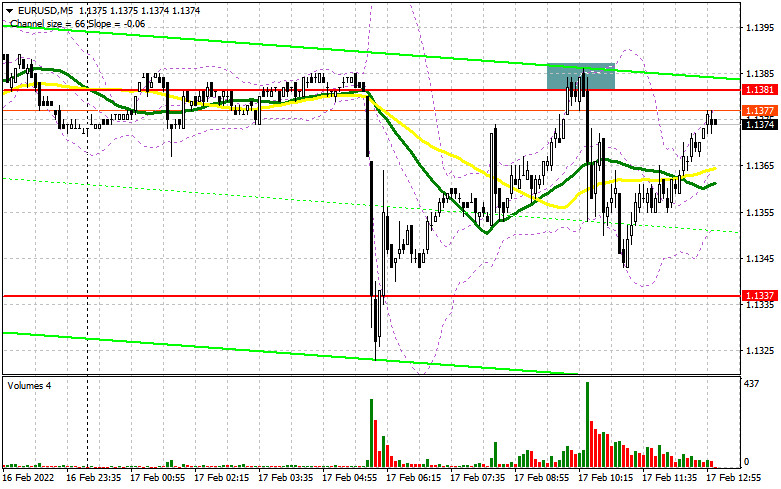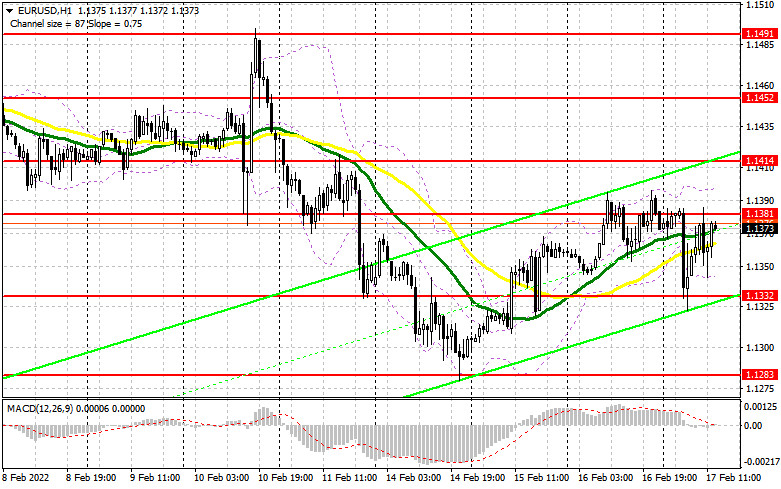
Conditions to open long positions on EUR/USD:
In the forecast I provided early today, I attracted your attention to the level of 1.1381. Let us take a look at the 5-minute chart and analyze the market situation. A jump in the euro after a massive sell-off during the Asian trade allowed buyers to regain control and touch the resistance level of 1.3181. The formation of a false breakout provided strong sell signals. As a result, the pair lost about 40 pips. From the technical point of view, the market situation will remain the same in the second part of the day.

During the US trade, we will see more significant fundamental factors that may influence the euro/dollar pair. Firstly, it is the US labor market report. A slump in the number of first-time claims may boost the US dollar since the employment rate is likely to fall. That is why a false breakout after a downward correction to the support level of 1.1332 remains the best condition to open buy orders on the euro. To continue the bullish trend, the pair should jump above the resistance level of 1.1381, which capped the euro's rise in the first part of the day. If the pair breaks the mentioned level and the US discloses weak data on labor market and Philly Fed manufacturing index, traders will receive a new buy signal. This may allow the pair to climb to 1.1414 and then to 1.1452, where it is recommended to lock in profits. If the pair continues falling during the US trade and fails to fix at 1.1332, bulls may face serious problems when forming a new upward channel. That is why it is better to avoid buying the euro until it hits 1.1283 and you see a false breakout. It is possible to buy the euro from 1.1235, expecting an upward correction of 20-25 pips.
Conditions to open sell positions on EUR/USD:
Sellers managed to keep control over the market, not allowing the euro/dollar pair to climb above 1.1381. However, they failed to push the pair to 1.1332. The fact is that demand for the euro surged. To keep control, bears should protect the resistance level of 1.1381. The formation of a false breakout of the mentioned level as well as strong data on the US labor market and hawkish comments made by FOMC member James Bullard may give a signal to open short positions with the target at 1.1332. Notably, the level is acting as intermediate support. If the pair upwardly breaks this level, traders may receive an additional signal to open short positions with the targets at such lows as 1.1283 and 1.1235. The level of 1.1200 may act as a farther target. There, it is recommended to lock in profits. However, such a tumble could be possible only in case of very strong data on the US labor market. If the euro rises and bears fail to protect 1.1381, it is better to avoid selling the asset. Short orders could be opened after the formation of a false breakout near 1.1414. Traders may open positions from 1.1452 or 1.1491, expecting a downward correction of 15-20 pips.

Commitment of Traders Report
The COT report from February 8 unveiled a rise in the number of long positions and a drop in the short ones. The report also takes into account the ECB's meeting where Christine Lagarde made it clear that the regulator would take aggressive measures if inflation continued rising. Last week, ECB members took the wait-and-see approach. Meanwhile, technical changes in the bullish market led to a decline in the euro/dollar pair. Demand for risk assets also decreased amid tensions between Russia and Ukraine. However, the depreciation was mainly caused by the Fed's actions concerning the key interest rate.
On Monday, February 14, the Federal Reserve held an emergency meeting, the results of which are still in secret. This, in turn, fuels concerns over high inflationary pressure. Some analysts suppose that the regulator may choose a more aggressive approach and hike the benchmark rate by 0.5% in March instead of raising it by 0.25% as planned earlier.It is a bullish signal for the US dollar.
The COT report reads that long non-commercial positions increased to 218,973 from 213,563, whereas the number of short non-commercial positions slid to 180,131 from 183,847. Such changes reflect the fact that traders continue opening long positions amid every decline in the euro. Thus, during the week, the total non-commercial net position inched up to 38,842 against 29,716. The weekly closing price jumped to 1.1441 against 1.1229 a week earlier.
Signals of indicators:
Moving Averages
Trading is conducted just below the 30- and 50-day moving averages, which indicates that the market remains under the control of sellers.
Note: The period and prices of moving averages are considered by the author on the one-hour chart that differs from the general definition of the classic daily moving averages on the daily chart.
Bollinger Bands
If the euro/dollar pair declines, the lower limit of the indicator located at 1.1345 will act as support. If the pair gains in value, the upper limit of the indicator located at 1.1390 will act as resistance.
Description of indicators
Moving average (moving average, determines the current trend by smoothing volatility and noise). The period is 50. It is marked in yellow on the chart. Moving average (moving average, determines the current trend by smoothing volatility and noise). The period is 30. It is marked in green on the graph. MACD indicator (Moving Average Convergence/Divergence - convergence/divergence of moving averages). A fast EMA period is 12. A slow EMA period is 26. The SMA period is 9. Bollinger Bands (Bollinger Bands). The period is 20. Non-profit speculative traders are individual traders, hedge funds, and large institutions that use the futures market for speculative purposes and meet certain requirements. Long non-commercial positions is a total long position opened by non-commercial traders. Short non-commercial positions is a total short position opened by non-commercial traders. The total non-commercial net position is a difference between the short and long positions opened by non-commercial traders.